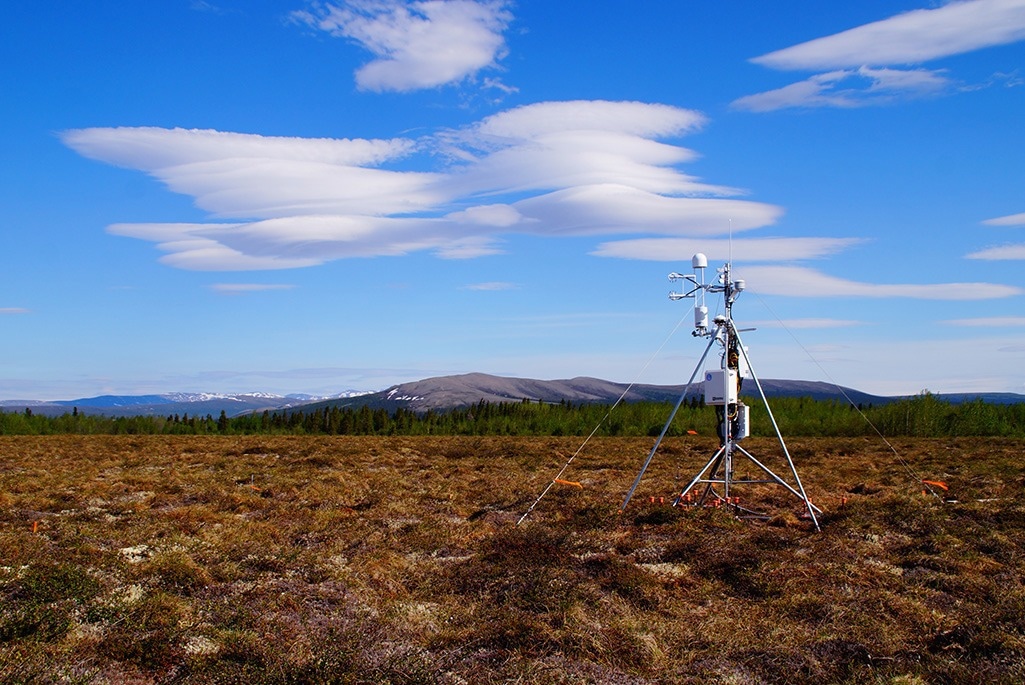Methane, a powerful greenhouse gas that warms the climate around 30 times more strongly than carbon dioxide, is mostly found in wetlands, which are Earth’s greatest natural sources of this gas. After examining data on wetland methane emissions throughout the Boreal-Arctic area, a study team from the Department of Energy’s Lawrence Berkeley National Laboratory (Berkeley Lab) discovered that these emissions have risen by almost 9% since 2002.
 A view of an eddy covariance tower, capable of measuring the release of greenhouse gases, located in Alaska. Image Credit: Sigrid Dengel
A view of an eddy covariance tower, capable of measuring the release of greenhouse gases, located in Alaska. Image Credit: Sigrid Dengel
The amount of methane released into the atmosphere annually by livestock and the production of fossil fuels has been extensively researched. Quantifying emissions from natural wetlands is crucial to anticipating climate change, notwithstanding the uncertainty.
Wetland methane emissions are predicted to rise as a result of temperatures in Boreal and Arctic ecosystems rising at a rate that is roughly four times faster than the global average. However, the precise amount of this increase is difficult to determine because it has been challenging to monitor emissions in these large, frequently wet environments up until this point.
Boreal and Arctic environments are carbon rich and vulnerable to warming.
Qing Zhu, Study Senior Author and Research Scientist, Lawrence Berkeley National Laboratory
The nine percent rise in emissions over the previous 20 years was discovered by the current study through the analysis of data gathered from many sophisticated monitoring techniques. Their methodology is described in a study that was published in Nature Climate Change.
Zhu added, “Rising temperatures increase microbial activity and vegetation growth which are associated with emissions of gasses like methane. By understanding how natural sources of methane are changing, we can more accurately monitor greenhouse gasses that inform scientists about the current and future state of climate change.”
Higher Latitude Wetlands: Quantifying Methane Emissions and How They Have Changed
Methane’s chemical makeup allows it to warm the atmosphere 30 times more than carbon dioxide, even though it remains in the atmosphere for a much shorter period of time (10 vs 300 years).
As frozen soils thaw and more precipitation falls in the form of rain rather than snow, higher temperatures boost the microbial activity of methane-releasing bacteria located in saturated soils and expand the region with water-logged soils where these microorganisms thrive.
For this reason, methane emissions should have grown in these higher-latitude locations, as predicted by experts, and it is imperative that methane be quantified more precisely.
The most popular method for measuring greenhouse gas emissions is to capture the gases released from soils at a specific site and let them accumulate over a certain amount of time in a chamber.
A different technique, the more independent several-meter-tall eddy covariance towers, measures greenhouse gas exchange continuously over wide areas of an ecosystem, including inaccessible regions like wetlands, between soils, plants, and the atmosphere.
A more comprehensive understanding of the factors influencing emissions over hundreds of acres of land and over minutes to decades was achieved by the Berkeley Lab research team by combining data obtained using both methods to analyze over 307 total years of methane emissions data across wetland sites in the Arctic-Boreal region.
The study team discovered that between 2002 and 2021, these areas’ wetlands generated an average of 20 teragrams of methane per year, which is equivalent to the weight of almost 55 Empire State skyscrapers. They also discovered that since 2002, emissions have gone up by around 9%.
Two “hotspot” regions in the Arctic and Boreal regions were also taken into consideration by the researchers, as they had significantly more methane emissions per area than the surrounding surroundings. They discovered that these hotspots accounted for around half of the average yearly emissions, which helps to focus mitigation efforts and future assessments.
Environmental Factors Affecting Wetland Emissions
Temperature and plant productivity were identified as the two main environmental elements that the researchers looked into further to determine which explained the greater methane emissions.
Microbial activity is enhanced by higher temperatures, and more methane is generated when temperatures rise, either generally as a result of climate change or sometimes as a result of climatic variability. The researchers discovered that in the Boreal-Arctic ecosystems, temperature acted as the primary regulator of wetland emissions and their variability.
This can result in climatic feedback, wherein rising air temperatures brought on by methane emissions from heightened microbial activity then trigger further methane emissions, and so on.
Higher plant production increases carbon in the soil, which feeds methane-producing microorganisms. The researchers discovered that when plants were more productive and engaged, they released substrates that let microorganisms grow, which boosted wetland methane emissions.
The researchers also discovered that 2016, the year with the largest wetland methane emissions, was the warmest in the high latitudes since 1950.
Managing Wetland Emissions as a Natural Climate Solution
Methane has a limited lifespan in the atmosphere. As a result, it can quickly be removed and reduced.
“By providing a more accurate understanding of the role wetlands play in the global climate system and how and at what pace their methane emissions have increased, this research can offer a scientific baseline to help understand and address climate change,” Zhu added.
NASA and the Department of Energy's Office of Science are funding this study.
Journal Reference:
Yuan, K., et. al. (2024) Boreal–Arctic wetland methane emissions modulated by warming and vegetation activity. Nature Climate Change. doi:10.1038/s41558-024-01933-3